A LEAK in the SAFETY GROUP DOES NOT MEAN THAT IT IS NOT WORKING. TO THE CONTRARY, THIS IS ONE OF ITS MAIN FUNCTIONS.
Frequent cases and explanations to detect what is normal or not:
A - Every evening at the same time, the safety group installed on the hot water tank leaks. Is this normal?
Yes, if the flow occurs whilst the tank is heating, and about 30 minutes after the end of the heating cycle. This is normal and the expected function by this safety component, which is the safety group.
This leak is due to the increase of volume by the expansion of water that is heated by the electrical immersion resistor in the tank. When water heats up, its volume increases, as does its pressure.
The safety group closes its non-return valve and thus impedes any return of hot water into the cold water supply circuit. This is the non-return function of the safety group.
To compensate for the expansion of the water, for 7 bars, the safety group opens to let a little water flow out and thus to compensate for the expansion of the water. It is therefore normal to find a trickle of water in the form of regular drops (corresponding with an average of 3% of the volume in the tank).
B - Every evening at the same time, the safety group installed on the hot water tank leaks, but in greater proportions. Is this normal?
No. As explained above, to compensate for the expansion of the water, for 7 bars, the safety group opens to let a little water flow out and thus to compensate for the expansion of the water.
We should find a trickle of water in the form of regular drops, corresponding with an average of 3% of the volume in the tank.
If there is a significant and permanent flow, the supply pressure of the network is too high at night (frequently due to lower water consumption at night). It is then necessary to install a water pressure reducer (REDUFIX type) near the safety group.
It is also possible to install an expansion vessel that will absorb the expansion of water and avoid too great an opening of the safety group (see WATTS expansion vessels and WATTS connection kit, art. 2292504N).
C - Every evening, but also during the day at different times, the safety group installed on the hot water tank leaks: Is this normal?
The safety group opens and leaks as soon as the pressure reaches 7 bars.
There can therefore be two causes:
- The supply pressure is over 7 bars, since there is no pressure reducer on the cold water supply,
- The pressure reducer is leaking.
If you have a pressure reducer on your installation (where you water supply enters the house or near the hot water tank), it is usually set to 3 bars. Thus, each time you open a hot water tap, you make the pressure drop in the tank and bring the mains water back up to 3 bars.
Check this when the safety group is flowing, by opening a hot water tap and finding that the valve flows less and then not at all.
If you have a pressure reducer and the flow does not slow when you open a hot water tap, the probable cause is the pressure reducer leaking.
It needs to be replaced.
D - What should I do if the safety group flows all the time?
This fault is due to there being a foreign body that prevents the valve from closing, or by the water being too corrosive or aggressive - and which damaged the safety group beyond repair.
It is usually a grain of sand, scale or a copper / brass shaving when work is being done on the plumbing or the installation.
These particles stick to the elastomer membrane of the valve and prevent the membrane from sealing against the valve face.
If the particle is not deeply embedded, you can try to remove it by opening the safety group knob completely. Otherwise, call a professional plumber and have him dismantle the valve with a special tool and clean the membrane.
If the elastomer membrane is damaged or too deeply marked, the valve module should be changed or even the whole safety group.
These particles do not always come from the mains water and can come from sediment or particles of scale that form in the hot water tank with time.
Unfortunately, installing a sediment filter does not solve this type of problem completely.
If the plumber finds, as he dismantles the valve, that the valve facing has been attacked by corrosion due to poor water quality (cf. E.G. 60.1), it is necessary to change the safety group. You are then strongly advised to install a safety group with a SFR STAINLESS STEEL type.
E – Is it possible for the safety group to open at a pressure of 3 or 4 bars?
No, safety groups made to French standards, and the SFR valves in particular, are designed to stringent specifications.
By their manufacture, the valve cannot open at a value of only 3 or 4 bars.
Each SFR safety group is manufactured, adjusted and checked individually in our BVQI (Bureau Veritas Quality International) ISO9001 certified factory.
The valve is set to 7 bars according to the NF standard. The tolerance required by this standard cannot be below 6.65 bars.
F - The safety group installed on 2 hot water tanks in series or in parallel (frequent in solar installations) is very hot. Is this normal?
We do not allow our safety groups to be used on installations of hot water tanks in series or in parallel.
Our safety groups have the advantage of a French standard right of use (NF EN 1487 NF-D 36401) and are thus intended, like all NF safety groups, for connection to a household cold water supply.
For installations using an installation of hot water tanks in series, we recommend the installation of household safety valves with a setpoint conforming to the water tank manufacturer’s recommendations. For solar installations, there are valves that are specially adapted for high temperatures (WATTS SV/E model).
G - A water hammer (a banging you can hear) is produced when I shut a tap of my installation. What should I do?
In the present installations, the use of increasing numbers of fast-closing appliances (single-control mixer tap, push-handle taps, washing machine solenoid valve, 1/4 turn taps, etc.) aggravate this phenomenon. These are the cause of a significant increase of water hammers, leading to:
• Rapid wear of equipment, sometimes even their sudden deterioration.
• Noises that do not comply with the present acoustic standards.
• Damage to the pipes and risks of leaks at the joints.
When a water hammer happens, the safety group might open to release a little water. When this happens, at the same time, a few particles in the water can be trapped between the valve facing and the elastomer membrane, thus causing a leak.
It is necessary to have one or several anti-hammer devices installed as near as possible to the appliance causing the water hammer (single-control mixer tap, push-handle taps, washing machine solenoid valve, 1/4 turn taps, etc.). We recommend the choice of pneumatic anti-hammer devices that are more efficient than the spring models.
H - What is the difference between a standard safety group and the SFR STAINLESS STEEL?
The SFR STAINLESS STEEL safety group is an upmarket appliance, the result of many encounters with professional plumbers. It meets with on-the-job problems found by plumbers and private persons, especially caused by water quality problems, increasingly aggressive and hard water.
• The stainless steel seat eliminates the risk of corrosion and any problems with the valve.
• The body of the SFR STAINLESS STEEL valve is equipped with a flat section above the drainage, which facilitates its installation and fitting direction.
• The valve, in the form of a removable module, can be changed with a special wrench (tool reserved to professional plumbers), without having to dismantle the entire valve unit.
• Its STAINLESS STEEL valve seat is practically invincible to all water qualities. Once the valve is dismantled, it is easy to clean the facing and re-screw the valve module. The safety group is immediately operational again.
The SFR, SFR STAINLESS STEEL, SFR angle body STAINLESS STEEL, and GSM 1" STAINLESS STEEL safety groups comply with standard NF-EN 1487 and have the advantage of the right to using the NF mark (NF EN1487 NF-D 36401).
I – Which safety group should I choose for which water quality?
The hardness of water in France is expressed in concentration by weight degree of hardness. One TH of 1°F (French degree) is equivalent to 10 grams of limestone per cubic metre. Soft water is more aggressive and therefore more corrosive than hard water.
Hard water leaves more solid scale, which clogs appliances and degrades the water tightness of equipment. For this reason, a removable and interchangeable valve is an advantage.
| |
Types of hot water storage heater |
Water qualities |
small capacities on
or under the sink max. power 4 kW |
on vertical stand
max. power 10 kW |
vertical on the wall
max. power
10 kW |
horizontal on the wall
max. power
10 kW |
on horizontal stand
max. power
10 kW |
horizontal big capacity
max. power
18 kW |
normal
water |
SFR NA53M2
1/2"
ref. 54310
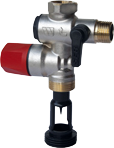
SFR NA53M2 1/2" angle body
art. 2254311M2
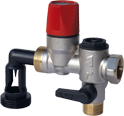
|
SFR 3/4" Standard
art. 2252550
|
SFR angle body stainless steel seat 3/4"
art. 2252571
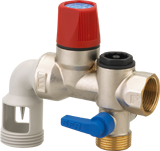
|
GSM 1" angle body
stainless steel seat art. 2254555M2
|
hard
water |
SFR NA53M2
1/2" stainless
steel seat
art. 2254312
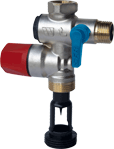
SFR NA53M2 1/2" angle body stainless steel seat
art. 2254313M2
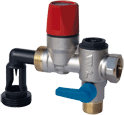
|
SFR PTFE 3/4"
art. 2252560
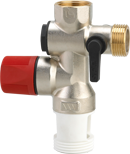
|
SFR stainless steel seat 3/4"
art. 2252570
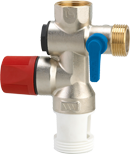
|
SFR Multi group 3/4" stainless steel seat straight / angle body
art. 2252573M2
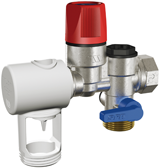
|
SFR angle body stainless steel seat 3/4"
art. 2252571

|
aggressive
water |
SFR stainless steel seat 3/4"
art. 2252570

|
SFR Multi group 3/4" stainless steel seat straight / angle body
art. 2252573M2

|
SFR Multi group 3/4"
stainless steel seat straight / angle body
art. 2252573M2

|

